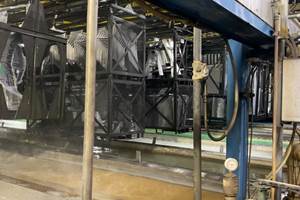Parts Cleaning: The Basics of Bases and Acids
Small changes in the pH of a cleaning bath can make the difference in achieving effective cleaning.
We take acids and bases for granted. Most of us know that passivation or pickling is performed in an acid solution. Some groups swear by nitric acidic but others strongly prefer the milder citric acid. Cleaning, on the other hand, is typically performed using basic cleaning agents.
The success of manufacturing processes can depend on the level of acids or bases in a process bath as well as the chemical composition of the acid or base. Let’s discuss acids and bases in general. Water (H20) can dissociate; this means a small number of water molecules become ions. Acids have a higher concentration of hydrogen ions (H+), and bases have a higher concentration of hydroxide ions (OH-). In neutral baths, there is a balance of H+ and OH-.
Understanding the pH Scale
Typically, we use the pH scale for monitoring process baths. Understanding pH is a must for successful cleaning, surface prep and coating. The pH scale is the negative (or inverse) of the logarithm of the hydrogen ion concentration: pH = - log[H+]. Aqueous process baths are often solutions. An aqueous solution is a single-phase mixture (like soda pop, not vinaigrette salad dressing) that contains water and at least one other chemical. A solution with a pH of 7 is neutral; basic solutions have a higher pH and acidic solutions have a lower pH. Most pH values range from 0 to 14.
By analogy, the Richter scale, which quantifies the amplitude of earthquake waves, is also a logarithmic scale. A magnitude 5 earthquake is 10 times as intense as one with a magnitude 4; the energy released is 30 times greater. Because the pH scale is also logarithmic, a small change in pH makes a big difference. A solution with pH 8 is 10 times more basic than one with pH 7.
Small changes in the pH of a cleaning bath can make the difference in achieving effective cleaning, which can make a difference in product yield. Small pH changes can cause undesirable interactions with the base metal or the polymer or whatever it is you are trying to clean, which can translate into surface quality issues like poor plating or coating resulting in disgruntled customers. This is why many assembly instructions call for checking the pH regularly.
Estimations by Color
Some varieties of hydrangeas produce flowers that are either pink or blue, depending on the pH of the soil they are grown in. In somewhat acidic soil (pH 5.2 to 5.5), the flowers are blue and at higher pH levels, the blooms are pink. Many natural products, like these flowers, can be used as pH indicators. Litmus is an indicator extracted from lichens that is red at low pH and blue at high pH.
In monitoring processes, one quick method of testing pH is to use pH strips, paper that has been impregnated with chemical indicators; molecules that, like hydrangea flowers, change color depending on the pH. pH papers with narrow ranges are available, however, process baths can be complex mixtures and with greater complexity comes the possibility of interfering reactions. For example, some cleaning agent residues can interfere with color changes. This can compromise accuracy of the measurements. Then, there is the matter of interpretation. A properly-calibrated optical spectrometer is objective (or at least consistent) but interpreting color by the human eye and human brain is subjective. What one person sees as “misty heather,” another may interpret as “muted violet.”
pH Meters for Accuracy and Objectivity
While pH paper is useful as a spot check for ongoing process monitoring, a pH meter is a better option.
Invented in the 1930s by industry icon Arnold O. Beckman while a professor at Cal Tech, a pH meter takes advantage of the fact that two solutions with differing pH form a weak battery. The pH is determined by measuring the difference in voltage between an unknown solution and a neutral (pH 7) potassium chloride solution. Between one solution and another with a 1-pH unit difference at ambient temperature, the voltage is about 60 mV. Since these differences are small and temperature-dependent, a pH meter requires calibration, and employees have to be trained and educated about correct use and maintenance.
If used properly, a pH meter provides relatively accurate and consistently objective measurements.
Originally published in the November 2016 issue.
Related Content
How to Maximize Nickel Plating Performance
The advantages of boric acid-free nickel plating include allowing manufacturers who utilize nickel plating to keep up the ever-changing regulatory policies and support sustainability efforts.
Read MoreSolvent Versus Aqueous: Busting the Myths
Is aqueous cleaning “greener” than solvent cleaning? Is solvent a more effective cleaner than aqueous? These and many other questions are answered here to debunk the misconceptions that many manufacturers have held onto for years.
Read MoreInstalling an Ecoat Line
Thinking of investing in electrocoating capabilities? George Lovell, coatings plant manager for Lippert, discusses considerations you should keep in mind as you add your ecoat line.
Read MoreTop Reasons to Switch to a Better Cleaning Fluid
Venesia Hurtubise from MicroCare says switching to the new modern cleaning fluids will have a positive impact on your cleaning process.
Read MoreRead Next
A ‘Clean’ Agenda Offers Unique Presentations in Chicago
The 2024 Parts Cleaning Conference, co-located with the International Manufacturing Technology Show, includes presentations by several speakers who are new to the conference and topics that have not been covered in past editions of this event.
Read MoreEpisode 45: An Interview with Chandler Mancuso, MacDermid Envio Solutions
Chandler Mancuso, technical director with MacDermid Envio discusses updating your wastewater treatment system and implementing materials recycling solutions to increase efficiencies, control costs and reduce environmental impact.
Read MoreEducation Bringing Cleaning to Machining
Debuting new speakers and cleaning technology content during this half-day workshop co-located with IMTS 2024.
Read More






















